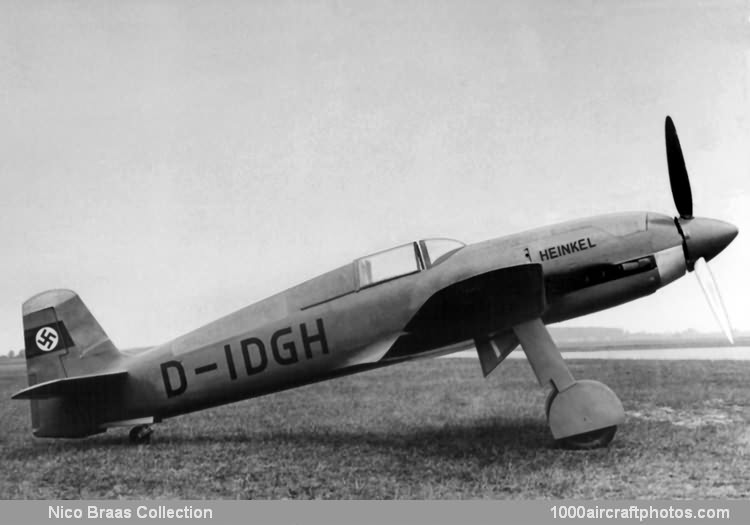11/15/2014. Remarks by Johan Visschedijk: "The Heinkel He 100 single-seat fighter was, for a considerable period of the war, an enigma. Allocated the designation He 113 by the Reichsluftfahrtministerium and much publicized under this type number by the German Propaganda Ministry, the fighter never, in fact, bore this appellation as, presumably on the grounds of superstition, the designation had been changed to that of He 100 while the aircraft was still under design. It was generally believed that the He 100 (alias He 113) had entered service with the Luftwaffe, but, the fighter was never accepted for service use. Only twelve production He 100 D-1 fighters were built and, in a successful attempt to mislead Allied Intelligence, these were repainted with different insignia several times and many propaganda photographs of the fighter distributed, leading to the erroneous belief that the He 100 was in widespread use.
The first prototype, the He 100 V1, was first flown on January 22, 1938, being rapidly followed by two further prototypes, the He 100 V2 (D-IUOS) and He 100 V3 (D-IDGH), with redesigned vertical tail surfaces. On June 6, 1938, the He 100 V3, flown by General Ernst Udet, captured the 62.137 mls (100 km) closed-circuit record at 394.148 mph (634.320 kmh). In an attempt to gain acclaim for the much-publicized He 112 fighter, at that time in limited production, the record-breaking aircraft was referred to as the He 112U, although it bore no relationship to the He 112 fighter.
The He 100 prototypes had a wing span of only 26 ft 10.75 in (8.20 m) and employed a system of surface evaporation cooling. Four further prototypes were built, the He 100 V4, to He 100 V7, these embodying modifications dictated by the results of an investigation into the crash of the He 100 V3 in September 1938, and incorporating service equipment. These were intended to serve as prototypes for the proposed He 100 B fighter (the designation He 100 A being applied to the Versuchs or experimental machines) and were intensively flight-tested by RLM pilots at Rechlin-Mueritz. The Rechlin pilots were highly enthusiastic over the He 100's speed but deplored its extremely high wing loading and poor handling qualities.
The Ernst Heinkei A.G. therefore abandoned the He 100 B and undertook an extensive redesign of the fighter in an attempt to improve its characteristics. The wing was redesigned and overall span increased to 30 ft 10.75 in (9.42 m) to reduce the wing loading, and the surface evaporation cooling system which had proved impossible to perfect to a standard required for general service use, was supplanted by a semi-retractable belly radiator. This version was designated He 100 D.
In the meantime, a further prototype had been constructed, the He 100 V8, which was intended specifically for an attempt on the World Air Speed Record. Retaining the surface evaporation cooling system of the earlier Versuchs machines, the He 100 V8 was fitted with a specially boosted version of the Daimler-Benz DB 601 engine which gave a maximum output of 1,800 hp for short periods. Flown by Hans Dieterle and again referred to as the He 112U, the He 100 V8 raised the Record to 463.92 mph (746.606 kmh) on March 30, 1939. Encouraged by this success, the Ernst Heinkel A.G. began the construction of three He 100 D-0 and twelve He 100 D-1 fighters. However, despite the superior performance of the He 100 D over the standard Bf 109 E fighter, the official attitude was that the war would be won with the Messerschmitt and that production capacity could not be afforded for the quantity production of the Heinkel fighter.
Thus, six of the Versuchs machines (He 100 V1, He 100 V2, He 100 V4 to He 100 V7) were sold to the Soviet Union, and the three pre-production He 100 D-0 fighters were sold to Japan in October 1939, together with a manufacturing license. The He 100 D-0s reached Japan in May 1940, were assembled at Kasumigaura, and were delivered to the Imperial Japanese Navy Air Service under the designation AXHei. Plans were prepared to manufacture the AXHei as a standard J.N.A.F. land-based interceptor, the Hitachi Kokuki K.K. being allocated this task. The construction of a factory to build the AXHei was started at Chiba, but Heinkel's inability to supply jigs and tools prevented the plan reaching fruition.
The twelve He 100 D-1 fighters were issued to a second-line squadron formed by Heinkel test pilots for the defense of the main Heinkel factory at Rostock-Marienehe."
